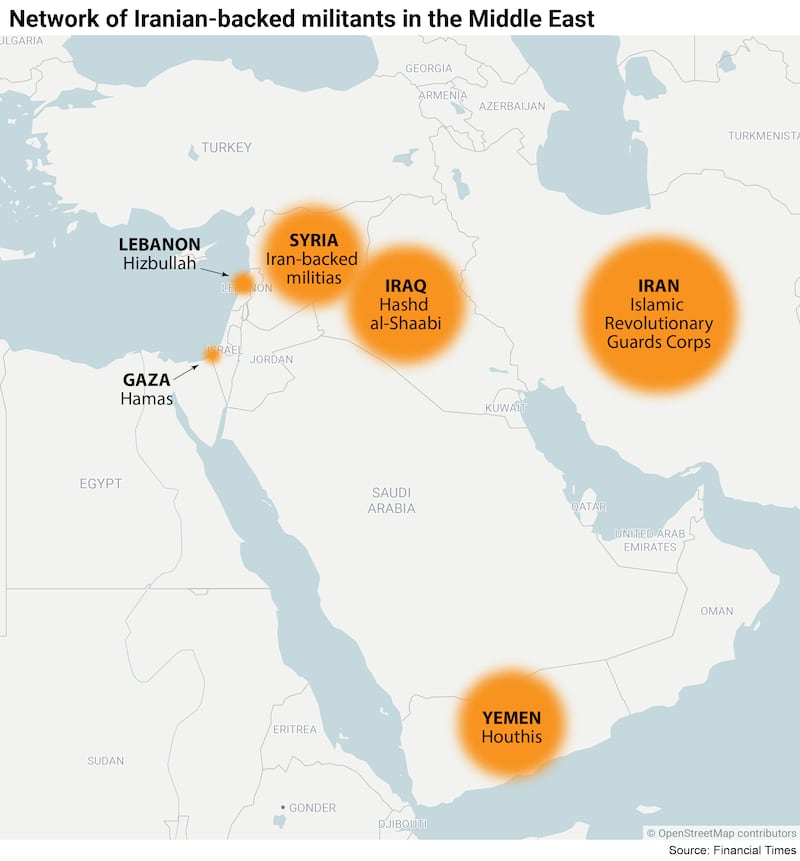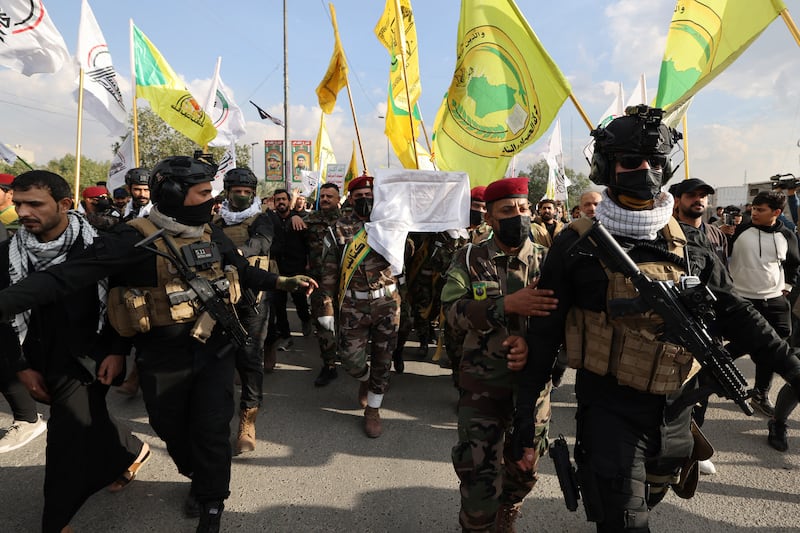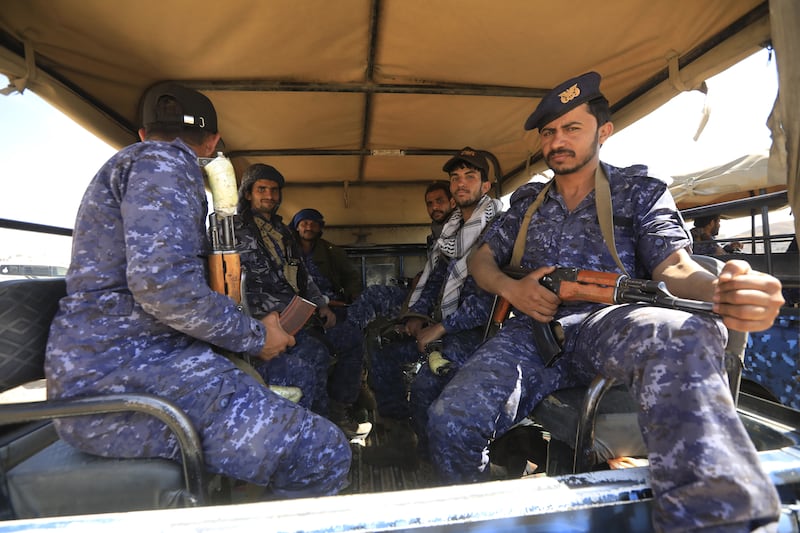The drone strike that killed three American soldiers at a base on the Syria-Jordan border underscored the simmering threat that US forces in the region have faced since the Israel-Hamas war broke out in October.
The attack on Sunday also highlighted the risks of the US being dragged deeper into regional hostilities triggered by war in Gaza.
The Biden administration blamed “radical Iran-backed militant groups” for the strike and vowed to hold “all those responsible to account at a time and in a manner of our choosing”. A network of Iran-backed militant groups across the region, which Tehran refers to as the “axis of resistance”, includes Hamas.
Ever since Hamas’s devastating October 7th attack on Israel, and the Jewish state’s ferocious retaliatory offensive on Hamas-run Gaza, the US has been conscious of the risks of a wider regional war erupting. It has sought to contain the conflict through a mix of diplomacy and deterrence.
READ MORE
But attacks on US forces, Israel and commercial shipping by militant groups supported by Iran have steadily escalated.
Iraqi militias
A significant US concern has been the escalation of attacks on its troops and personnel from militias in Iraq. Some 2,000 to 2,500 American soldiers are based in Iraq, training Iraqi forces and seeking to help prevent a resurgence of the jihadist group Islamic State.
Iraqi militias have carried out more than 140 attacks against US forces in Iraq and Syria – where another 900 troops are deployed in the fight against Islamic State, also known as Isis – since October 17th. They have also claimed to have launched strikes against the city of Eilat in southern Israel.
The attacks have been carried out by a shadowy group known as the “Islamic Resistance of Iraq”. On Sunday, it said it launched armed drones against three military bases with US personnel in Syria, including one across the border from the base where the three Americans were killed. But it was not clear whether this was the attack that killed the US troops.
Analysts believe the “Islamic Resistance of Iraq” is a front for Iran-backed factions within an umbrella of militias known as Hashd al-Shaabi. These have become powerful military and political forces with tens of thousands of fighters, and are integrated into the state.
Many of the Shia militias’ leaders have historical links to Iran, having lived and trained in the Islamic republic when Saddam Hussein, a Sunni, ruled Iraq. They returned to Iraq after the 2003 US-led invasion, where they fought against US-led coalition forces and became embroiled in sectarian violence.
Their political and military influence in Iraq rose significantly after they played a role in countering Islamic State’s blitz across the country in 2014.
The more extreme factions have a history of targeting American bases and personnel in Iraq whenever there is a flare-up of tension between the US and Iran.

Hizbullah threat
A big worry for Washington has been the risk of a ramp-up in fighting on Israel’s northern border involving Hizbullah, the powerful Iran-backed Lebanese militant group, as the Jewish state’s offensive in Gaza rumbles on.
Hizbullah fought a 34-day war with Israel in 2006 and is estimated to have 20,000 to 50,000 fighters and an arsenal of attack drones, small arms, artillery, tanks and increasingly sophisticated precision-guided missiles. There are also Palestinian militants in Lebanon.

Israeli forces and Hizbullah – as well as Palestinian militants in Lebanon – have exchanged almost daily cross-border fire since October 7th. The clashes have escalated, but so far have stopped short of full-blown conflict. The fear is that a provocation or miscalculation by either side takes them to a new level.
Militant groups in Syria
Numerous Iran-backed militias operate in Syria, where Iran intervened militarily to back President Bashar al-Assad after a popular 2011 uprising against his regime morphed into civil war.
Rather than deploying large numbers of its own forces in Syria, Tehran mobilised and sent Shia militant groups, including Lebanon’s Hizbullah, and Syrian and foreign militias to fight alongside Assad regime troops.
In doing so, they set up bases in southern Syria, creating another front to target Israel and the occupied Golan Heights. Since the war between Israel and Hamas broke out, several rockets and mortars have been fired into the Golan Heights.
Houthi rebels in Yemen
Further afield, Houthi rebels, who control northern Yemen, have also sought to strike Israel and launched multiple attacks against merchant ships in the Red Sea and Gulf of Aden.
The disruption to global maritime trade has drawn the US and UK into combat as they launched attacks against the Houthis’ military infrastructure in Yemen. The rebels have continued to attack shipping and US naval vessels.

The battle-hardened Houthis have been fighting in a more than eight-year war against a Saudi-led coalition that intervened to support Yemen’s ousted government.
Since 2015, the rebels have launched hundreds of missile and drone attacks into Saudi Arabia. Last year they also struck Abu Dhabi.
The Houthis, members of the Zaydi sect of Shia Islam, are less ideologically aligned to Iran than some of the other regional militant groups. But the US and Gulf states accuse Tehran of supplying the Houthis with intelligence and missile and drone technology.
Iran’s own forces
In Iran itself, the 120,000-strong elite Revolutionary Guards are the main threat to Israeli and western targets. Its wing responsible for foreign operations, the powerful Quds force, also co-ordinates and trains Tehran’s regional proxies.
As former president Donald Trump mounted his “maximum pressure” policy against the republic, the US blamed Iran for sabotaging tankers in the Gulf and for a sophisticated missile and drone attack on Saudi Arabia’s oil infrastructure in 2019, which temporarily knocked out half the kingdom’s crude output. The guards also shot down a US spy drone that year.
During that period of heightened tensions, Iranian hardliners often threatened to disrupt shipping through the Strait of Hormuz, through which a third of all seaborne oil cargoes pass.
This month, Iran seized an oil tanker in the Gulf of Oman and launched missile strikes against what it called an Israeli “espionage centre” in Erbil in Iraq. That attack came after an Israeli strike killed a senior guards officer in Syria and other attacks by the Jewish state killed a Hamas leader in Beirut.
However, Iran insists it wants to avoid full-blown regional conflict, and western diplomats believe Tehran’s calculus is to stay on the sidelines of the Israel-Hamas war.
US presence in the region
In the first days of the war, the US dispatched two carrier strike groups to the region in a show of force and support for Israel. It has also deployed air defence systems, a nuclear-powered submarine and more than 3,000 additional troops to protect American forces and to deter Iran and the militant groups it supports.
The deployments add to the muscular military presence the US already retained across the Middle East.
Its largest base in the region is Al Udeid in Qatar, but other countries with a US presence include the UAE, Kuwait, Saudi Arabia and Bahrain.
The number of American troops in the region has fluctuated since the 2003 invasion of Iraq. US troop levels in Iraq peaked at 170,000 in 2007 before Washington eventually withdrew all combat troops in 2011.
After that, the number of US troops in the Middle East is estimated to have been between 40,000 and 50,000. Some 2,000 US troops were sent back to Iraq in 2014 to help fight Islamic State.
Trump then ramped up the US’s military footprint in the region between 2019 and 2020, as tensions rose with Iran. Under Trump, troop levels peaked between 60,000 and 70,000.
When President Joe Biden took office, he sought to de-escalate tensions and oversaw the chaotic US withdrawal from Afghanistan in 2021. The same year, the Pentagon pulled some air defences from Saudi Arabia.
More than 20 Patriot batteries remained there and the US continues to have more than 57,000 troops in the Middle East, according to estimates from the International Institute for Strategic Studies.
But the pullout from Afghanistan and decision to rotate out the Patriots worsened the perception in the Arab world that successive US administrations had been disengaging from the region.
Now the Israel-Hamas war is drawing American troops back into conflict. – Copyright The Financial Times Limited 2024
- Sign up for push alerts and have the best news, analysis and comment delivered directly to your phone
- Find The Irish Times on WhatsApp and stay up to date
- Our In The News podcast is now published daily - Find the latest episode here




















